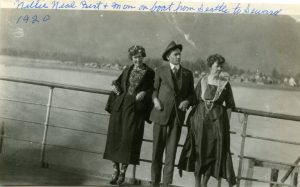We’ve been on hiatus with our archives-themed cooking events for a few years, but it looks like it might just be time to bring it back to life. You might recall the Chilkoot Challenge in which we took the grocery list for Klondike stampeders and challenged folks to make food that incorporated those ingredients. Or the Military menus or the Steamship menus events, both of which turned into sit-down luncheons.
Or you might even remember the original Convalescents’ Banquet which started the whole thing back in 2014 when we decided to celebrate Public Health Week by making recipes from a 1875 book in the Rare Books collection on the home care and feeding of sick folks. As one of our colleagues quipped about the results: the food would either kill you off or force you to get out of bed just to get proper food again. You know it’s not going to be good when the meat tenderizer used in the few meat recipes is hydrochloric acid. (Note to HR: we didn’t do any of the recipes that called for it.)
That’s all a really long introduction to this year’s theme and challenge. In 1920, the Anchorage Woman’s Club, whose records we hold, had a Home Economics Department. And that group published a cookbook made up of recipe submissions from Club members. The Club ended up publishing a number of these books over the years, but the 1920 book was the very first. We’ve recently digitized it and put it up on the Alaska’s Digital Archives. Since they were coming out of a worldwide pandemic at the time and well, you know, it seemed a timely choice.
So here’s the event details: Go take a look at the cookbook. Pick a recipe (or three!) Prepare them. Bring them to the Consortium Library Room 307 between 2:30 and 3:00 pm on Thursday, May 5. Feel free to bring enough to share with more than a few folks, but please have enough for small samples to be provided to our panel of distinguished tasters (i.e. the folks we could wrangle into performing this service for us.) At 3:00 we’ll convene our panel, have them taste-test the various foods, and give us their feedback on them. If you bring enough to share more widely, please also bring a list of the ingredients you used in the recipe for any of our fellow attendees who may have food allergies or intolerances.We’ll have basic plates, forks, spoons, but if you’ll need any serving utensils or specialized containers (bowls/cups/etc), please bring those with you. Please do not plan to do any active cooking at the event—microwave reheating, crockpots, similar may be possible, just no on-site cookery. Shoot us an email through the contact us link if you have any questions.
The cookbook is surprisingly diverse, given what you might assume about the food supply chain in Anchorage in 1920. But there’s still a fair amount of reliance on canned foods. And quite a few recipes related to Alaskan game meats. And it could be that some of the food diversity is coming from recipes that were imported with Alaskan transplants and maybe were more aspirational for Anchorage than achievable. But maybe there’s some historical foodways lessons to be learned, whether or not they were typical of food available in Anchorage households.
And if you decide to dress in the spirit of 1920 to eat this food, have at it! Here’s a few photos of folks either in Alaska or en route to Alaska in 1920 or thereabouts to provide some inspiration.








